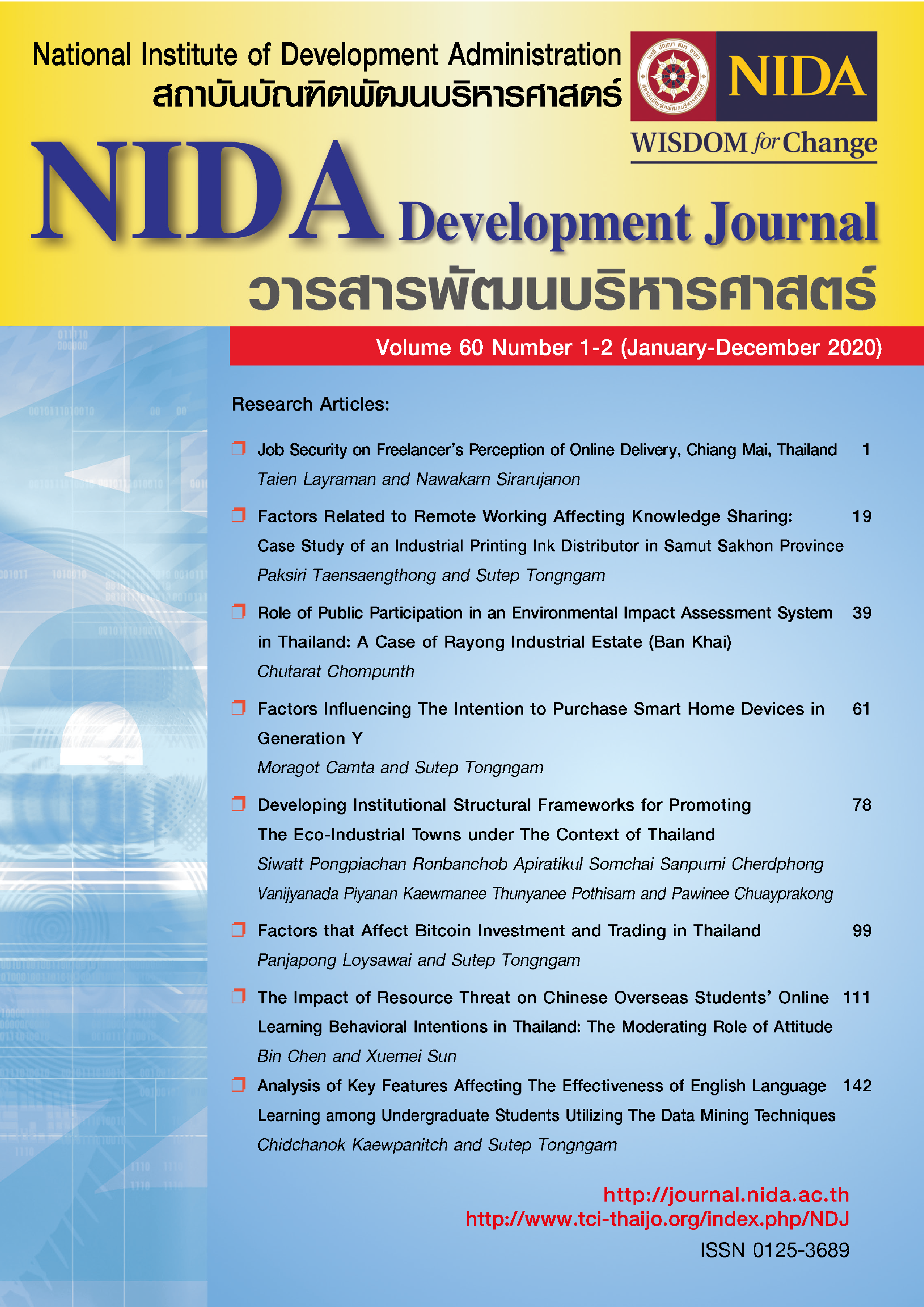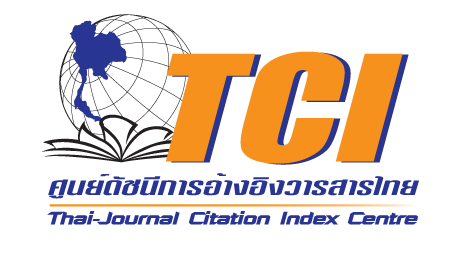The Impact of Resource Threat on Chinese Overseas Students' Online Learning Behavioral Intentions in Thailand: The Moderating Role of Attitude
Keywords:
COR Theory, Social Impact, Behavioral Intention, Moderating Effect of AttitudeAbstract
Under the influence of social disruption, university students experience a significant loss effect on their resources, which greatly impacts their learning motivation. This study, based on Conservation of Resources Theory (COR) combining Social Impact Theory (SIT), examines students' willingness to adopt online learning under considerable pressure during significant social environmental changes. The research explores the potential moderating role of attitude towards online learning, shaped by factors such as social isolation and fear of the virus.
This study employs Partial Least Squares Structural Equation Modeling (PLS-SEM) based on COR theory and SIT for empirical analysis. A survey was conducted among Chinese students studying in Thailand (n=527), using online questionnaires and convenience sampling to collect data.
The analysis demonstrates that the model created for this study exhibits a good fit with the data. Exogenous latent variables, such as social influence resource (SIR), personal performance resources (PPR) show a positive correlation with online learning behavioral intentions(BI) (R2=0.379). Moreover, social isolation (SI) and COVID-Fear (CF) have a significant positive impact on the attitude(R2=0.148) toward online learning. Simultaneously, attitude(ATT) exerts a negative moderating effect on the relationship between PPR and BI.
By employing COR theory, this study reveals that students are willing to prevent further resource depletion when resources are threatened, they are more inclined to engage in online learning when facing social isolation and pandemic fear, mitigating the impact of social impact. The research uncovers a significant negative moderating effect of attitude on the relationship between individual performance resources and behavioral intentions.
References
Ahorsu, D. K., Lin, C.-Y., Imani, V., Saffari, M., Griffiths, M. D., & Pakpour, A. H. (2020). The Fear of COVID-19 Scale: Development and initial validation. International Journal of Mental Health and Addiction. https://doi.org/10.1007/s11469-020-00270-8
Azizan, S. N., Lee, A. S. H., Crosling, G., Atherton, G., Arulanandam, B. V., Lee, C. E., & Rahim, R. B. A. (2022). Online Learning and COVID-19 in Higher Education: The Value of IT Models in Assessing Students' Satisfaction. International Journal of Emerging Technologies in Learning, 17(3), 245-278. https://doi.org/10.3991/ijet.v17i03.24871
Basilaia, G., & Kvavadze, D. (2020). Transition to Online Education in Schools during a SARS-CoV-2 Coronavirus (COVID-19) Pandemic in Georgia. Pedagogical Research, 5(4). https://doi.org/10.29333/pr/7937
Brislin, R. W. (1970). Back-Translation for Cross-Cultural Research. Journal of Cross-Cultural Psychology, 1(3), 185-216. https://doi.org/10.1177/135910457000100301
Cao, J., Yang, T., Lai, I. K. W., & Wu, J. (2021, Jan 20). Is online education more welcomed during COVID-19? An empirical study of social impact theory on online tutoring platforms. International Journal of Electrical Engineering & Education. https://doi.org/Artn10.1177/0020720920984001
Cao, W., Fang, Z., Hou, G., Han, M., Xu, X., Dong, J., & Zheng, J. (2020, 2020/05/01/). The psychological impact of the COVID-19 epidemic on college students in China. Psychiatry Research, 287, 112934. https://doi.org/https://doi.org/10.1016/j.psychres.2020.112934
de Jong Gierveld, J., Van Tilburg, T., & Dykstra, P. A. (2006). Loneliness and social isolation. Cambridge handbook of personal relationships, 485-500.
Devisakti, A., & Ramayah, T. (2019). E-Learning Usage Outcomes among University Learners: A Pilot Study. Journal of Education and e-Learning Research, 6(3), 149-155. https://doi.org/10.20448/journal.509.2019.63.149.155
Fishbein, M., & Ajzen, I. (1977). Belief, attitude, intention, and behavior: An introduction to theory and research. Philosophy and Rhetoric, 10(2).
Fornell, C., & Larcker, D. F. (1981). Evaluating Structural Equation Models with Unobservable Variables and Measurement Error. Journal of Marketing Research.
García Botero, G., Questier, F., Cincinnato, S., He, T., & Zhu, C. (2018). Acceptance and usage of mobile assisted language learning by higher education students. Journal of Computing in Higher Education, 30(3), 426-451. https://doi.org/10.1007/s12528-018-9177-1
Hair, J. F., Jr., W. C. B., Babin, B. J., & Anderson, R. E. (2019). Multivariate Data Analysis. CENGAGE. (EIGHTH EDITION)
Hair, J. F., Risher, J. J., Sarstedt, M., & Ringle, C. M. (2019). When to use and how to report the results of PLS-SEM. European business review, 31(1), 2-24. https://doi.org/10.1108/EBR-11-2018-0203
Hamid, M. R. A., Sami, W., & Sidek1, M. H. M. (2017). Discriminant Validity Assessment: Use of Fornell &Larcker criterion versus HTMT Criterion. Journal of Physics: Conference Series. https://doi.org/10.1088/1742-6596/890/1/012163
Hasan, N., & Bao, Y. (2020, 2020/11/01/). Impact of “e-Learning crack-up” perception on psychological distress among college students during COVID-19 pandemic: A mediating role of “fear of academic year loss”. Children and Youth Services Review, 118, 105355. https://doi.org/https://doi.org/10.1016/j.childyouth.2020.105355
Henseler, J., Hubona, G., & Ray, P. A. (2016). Using PLS path modeling in new technology research: updated guidelines. Industrial Management & Data Systems. https://doi.org/10.1108/IMDS-09-2015-0382
Henseler, J., Ringle, C. M., & Sarstedt, M. (2014). A new criterion for assessing discriminant validity in variance-based structural equation modeling. Journal of the Academy of Marketing Science, 43(1), 115-135. https://doi.org/10.1007/s11747-014-0403-8
Henseler, J., Ringle, C. M., & Sinkovics, R. R. (2009). The use of partial least squares path modeling in international marketing. In New Challenges to International Marketing (pp. 277-319). https://doi.org/10.1108/s1474-7979(2009)0000020014
Hobfoll, S. E. (1988). The ecology of stress. Taylor & Francis.
Hobfoll, S. E. (1989). Conservation of resources: A new attempt at conceptualizing stress. American Psychologist, 44(3), 513. https://doi.org/10.1037/0003-066X.44.3.513
Hobfoll, S. E. (2002, 2002/12/01). Social and Psychological Resources and Adaptation. Review of General Psychology, 6(4), 307-324. https://doi.org/10.1037/1089-2680.6.4.307
Hwang, T.-J., Rabheru, K., Peisah, C., Reichman, W., & Ikeda, M. (2020). Loneliness and social isolation during the COVID-19 pandemic. International psychogeriatrics, 32(10), 1217-1220. https://doi.org/10.1017/S1041610220000988
Jongpil Cheon , S. L., Steven M. Crooks , Jaeki Song (2012). An investigation of mobile learning readiness in higher education based on the theory of planned behavior. Computers & Education. https://doi.org/10.1016/j.compedu.2012.04.015
Kelman, H. C. (1958). Compliance, identification, and internalization three processes of attitude change. Journal of conflict resolution, 2(1), 51-60.
Kock, N. (2015). Common method bias in PLS-SEM: A full collinearity assessment approach. International Journal of e-Collaboration (ijec), 11(4), 1-10. https://doi.org/10.4018/ijec.2015100101
Latane, B. (1981). The Psychology of Social Impact. American Psychologist.
Latane, B. (1996). Dynamic Social Impact The Creation of culture by communication.pdf. Journal of Communication.
Mbah, R. E., & Wasum, D. F. (2022). Russian-Ukraine 2022 War: A review of the economic impact of Russian-Ukraine crisis on the USA, UK, Canada, and Europe. Advances in Social Sciences Research Journal, 9(3), 144-153. https://doi.org/10.14738/assrj.93.12005
Mertens, G., Gerritsen, L., Duijndam, S., Salemink, E., & Engelhard, I. M. (2020). Fear of the coronavirus (COVID-19): Predictors in an online study conducted in March 2020. Journal of anxiety disorders, 74, 102258. https://doi.org/10.1016/j.janxdis.2020.102258
Ngampornchai, A., & Adams, J. (2016, Oct 10). Students' acceptance and readiness for E-learning in Northeastern Thailand. International Journal of Educational Technology in Higher Education, 13. https://doi.org/ARTN 34 10.1186/s41239-016-0034-x
Or, C., & Chapman, E. (2022, Jan 10). Development and validation of an instrument to measure online assessment acceptance in higher education. British Journal of Educational Technology. https://doi.org/10.1111/bjet.13180
Ping Qiao, X. Z., Yangzhi Guo , Ying Sun and Chuan Qin. (2021). The Development and Adoption of Online Learning in Pre- and Post-COVID-19: Combination of Technological System Evolution Theory and Unified Theory of Acceptance and Use of Technology. Journal of Risk and Financial Management. https://doi.org/10.3390/jrfm14040162
Raza, S. A., Qazi, W., Khan, K. A., & Salam, J. (2021, Apr). Social Isolation and Acceptance of the Learning Management System (LMS) in the time of COVID-19 Pandemic: An Expansion of the UTAUT Model. Journal of Educational Computing Research, 59(2), 183-208. https://doi.org/10.1177/0735633120960421
Rui, S., Keiman, W., Jiaxi, L., Kinlong, L., Youmin, Z., & Xue, Y. (2021). How COVID-19 stress related to schooling and online learning affects adolescent depression and Internet gaming disorder: Testing Conservation of Resources theory with sex difference. Journal of behavioral addictions. https://doi.org/10.1556/2006.2021.00069
Sabah, N. M. (2016). Exploring students' awareness and perceptions: Influencing factors and individual differences driving m-learning adoption. Computers in Human Behavior, 65, 522-533. https://doi.org/10.1016/j.chb.2016.09.009
Sakka, Y. M. H. (2022, Feb 23). Students' Acceptance of Distance Learning as a Result of COVID-19 Impact on Higher Education in Jordan. Education Research International, 2022. https://doi.org/10.1155/2022/7697947
Sitar‐Tăut, D. A. (2021). Mobile learning acceptance in social distancing during the COVID‐19 outbreak: The mediation effect of hedonic motivation. Human Behavior and Emerging Technologies, 3(3), 366-378. https://doi.org/10.1002/hbe2.261
Spector, P. E. (2019, 2019/04/01). Do Not Cross Me: Optimizing the Use of Cross-Sectional Designs. Journal of Business and Psychology, 34(2), 125-137. https://doi.org/10.1007/s10869-018-09613-8
Stevan E. Hobfoll, J. H., 2 Jean-Pierre Neveu,3 and Mina Westman4. (2018). Conservation of Resources in the Organizational Context: The Reality of Resources and Their Consequences. Annual Review of Organizational Psychology and Organizational Behavior. https://doi.org/10.1146/annurev-orgpsych-032117-104640
Sun, X., & Ma, Y. (2022). How The Perceived Threat of Covid-19 Aggravates Chinese Employees’ Emotional Exhaustion and Turnover Intention in Thailand: The Moderating Role of Affective Commitment. Creative Business and Sustainability Journal (CBSJ).
Tenenhaus, M., Vinzi, V. E., Chatelin, Y.-M., & Lauro, C. (2005, 2005/01/01/). PLS path modeling. Computational Statistics & Data Analysis, 48(1), 159-205. https://doi.org/10.1016/j.csda.2004.03.005
Thomas, T., Singh, L., & Gaffar, K. (2013). The utility of the UTAUT model in explaining mobile learning adoption in higher education in Guyana. International Journal of Education and Development using ICT, 9(3).
Urbach, N., & Ahlemann, F. (2010). Structural Equation Modeling in Information Systems Research Using Partial Least Squares. Journal of information technology theory and application.
Venkatesh, V., Morris, M. G., Davis, G. B., & Davis, F. D. (2003). User acceptance of information technology: Toward a unified view. MIS Quarterly, 27, 425-478. https://doi.org/10.2307/30036540
Viswanath Venkatesh, James Y. L. Thong, Frank K. Y. Chan, & Brown, P. J.-H. H. S. A. (2011). Extending the two-stage information systems continuance model: incorporating UTAUT predictors and the role of context. Information Systems Journal. https://doi.org/10.1111/j.1365-2575.2011.00373.x
Wong, K. K.-K. (2013). Partial least squares structural equation modeling (PLS-SEM) techniques using SmartPLS. Marketing Bulletin, 24(1), 1-32.
Yunus, M. M., Ang, W. S., & Hashim, H. (2021, Mar). Factors Affecting Teaching English as a Second Language (TESL) Postgraduate Students' Behavioural Intention for Online Learning during the COVID-19 Pandemic. Sustainability, 13(6). https://doi.org/10.3390/su13063524
Downloads
Published
How to Cite
Issue
Section
License
Copyright (c) 2024 NIDA Development Journal

This work is licensed under a Creative Commons Attribution-NonCommercial-NoDerivatives 4.0 International License.





